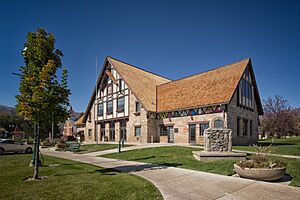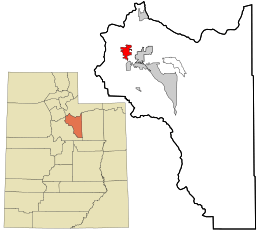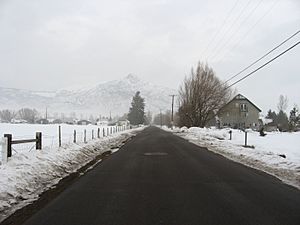Midway, Utah facts for kids
Quick facts for kids
Midway, Utah
|
|
|---|---|

Town Hall
|
|

Location in Wasatch County and the state of Utah
|
|
| Country | United States |
| State | Utah |
| County | Wasatch |
| Settled | 1859 |
| Area | |
| • Total | 5.55 sq mi (14.37 km2) |
| • Land | 5.55 sq mi (14.37 km2) |
| • Water | 0.00 sq mi (0.00 km2) |
| Elevation | 5,653 ft (1,723 m) |
| Population | |
| • Total | 6,003 |
| • Density | 951.35/sq mi (367.33/km2) |
| Time zone | UTC-7 (Mountain (MST)) |
| • Summer (DST) | UTC-6 (MDT) |
| ZIP code |
84049
|
| Area code(s) | 435 |
| FIPS code | 49-49820 |
| GNIS feature ID | 2411101 |
Midway is a city in Wasatch County, Utah, United States. It is located in the Heber Valley. Midway is about 3 miles west of Heber City. It is also about 28 miles southeast of Salt Lake City. The city sits on the other side of the Wasatch Mountains. In 2020, the population of Midway was 6,003 people.
Contents
History of Midway
The first known European-Americans visited the Midway area in 1824. They were part of a group of fur trappers led by Étienne Provost. This group explored the region, which was then called Upper Provo. The name came from the Provo River that flows through the valley. These early visitors did not stay permanently. Their journey, however, began the exploration of the area.
In the mid-1850s, settlers started moving into the Heber Valley. They were encouraged by loggers who found fertile land there. Settlers from Utah Valley asked the government to build a road. This road would go up the Provo Canyon. The governor, Brigham Young, supported this idea. In 1858, the road through Provo Canyon was built. This made it easier for people to settle in the valley.
Early attempts to settle in 1855 and 1857 failed. Harsh winters forced the settlers to leave temporarily. Permanent settlement began in 1858-1859. Settlers created small communities in the valley. Two of these were west of the Provo River. They were called the "upper settlement" and "lower settlement." These were located on the Snake Creek River. The upper settlement was also known as Mound City. It was named after the nearby limestone formations.
In the 1860s, the upper and lower settlements joined together. This new combined settlement became Midway. It was named this because it was the site of Fort Midway. This fort was halfway between the two original settlements. A post office named Midway was operating by 1864. The place where Fort Midway once stood is now the town square.
Geography and Climate
Midway covers an area of about 3.3 square miles (8.7 km2). All of this area is land. The region where Midway is located is known as the Wasatch Back. Snake Creek flows through Midway from north to south. The Midway Fish Hatchery is located on this creek. The creek then joins the Provo River above Deer Creek Reservoir.
Midway's Climate
Midway has a climate with big temperature changes during the year. Summers are warm to hot. Winters are cold, sometimes very cold. This type of weather is called a humid continental climate.
Midway's Geology
The Wasatch Fault runs beneath Midway. This includes the main fault line west of town. The Bald Mountain Fault also runs through the valley. The movement of these faults created some of the mountains around Midway. They also caused the unique limestone mounds, called "potrock." The faults are also why there are many hot springs in the area.
Population Information
| Historical population | |||
|---|---|---|---|
| Census | Pop. | %± | |
| 1870 | 378 | — | |
| 1880 | 718 | 89.9% | |
| 1890 | 769 | 7.1% | |
| 1900 | 939 | 22.1% | |
| 1910 | 1,003 | 6.8% | |
| 1920 | 805 | −19.7% | |
| 1930 | 745 | −7.5% | |
| 1940 | 801 | 7.5% | |
| 1950 | 711 | −11.2% | |
| 1960 | 713 | 0.3% | |
| 1970 | 804 | 12.8% | |
| 1980 | 1,194 | 48.5% | |
| 1990 | 1,554 | 30.2% | |
| 2000 | 2,121 | 36.5% | |
| 2010 | 3,845 | 81.3% | |
| 2020 | 6,003 | 56.1% | |
| 2022 (est.) | 6,217 | 61.7% | |
| U.S. Decennial Census | |||
In 2010, Midway had a population of 3,845 people. Most of the people were non-Hispanic White (92.6%). About 5.5% of the population was Hispanic.
In 2000, there were 2,121 people living in Midway. About 43.2% of households had children under 18. The average household had about 3 people. The median age in the city was 31 years old.
Arts and Culture
Midway is known for its Swiss-style architecture. Some neighborhoods even require new homes to have Swiss design elements. Architect John Watkins lived in Midway. Some of his buildings, like the Watkins–Coleman House, are still standing. The John H. and Agnes Buehler House, built in 1893, is sometimes called the "Hobbit house" or "mushroom house."
Midway Swiss Days is a popular event. It started in 1947 to attract visitors to Midway. The Swiss theme was created by Orma W. Wallengren. Her family owned a local resort.
Other art events include Art Around the Square. There is also the Midway Arts Center.
Soldier Hollow is a fun place to visit. It features the Utah Ice Castles in winter. You can also enjoy cross-country skiing and a tubing hill there.
Parks and Recreation
Wasatch Mountain State Park is located in north Midway. It is on Snake Creek.
The Homestead caldera is a resort in Midway. It has a special geo-thermal pool. This pool is warm all year round. People can even go scuba diving in its warm water.
Media Mentions
A scene from the movie 127 Hours was filmed in Midway. The scene where the main character and two girls fall into a hidden pool was shot at the Homestead caldera.
Notable People
- Arthur V. Watkins
- John Watkins
- Dean Hughes
- Mike Massey
- Mike Kohler
See also
 In Spanish: Midway (Utah) para niños
In Spanish: Midway (Utah) para niños


